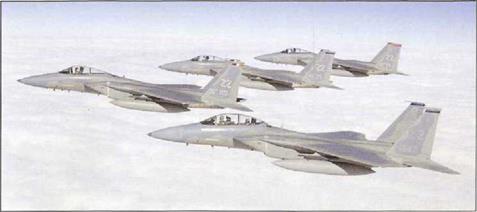Boeing F-15A, F-15B, F-15C, F-15D Air superiority fighter
|
|
T |
he McDonnell Douglas-designed F-15 Eagle is viewed as the world’s best air superiority fighter and interceptor, particularly in the BVR [beyond visual range) air-to-air mission. It was designed for the USAF’s 1966 FX requirement which called for a long-range air superiority fighter to replace the F-4. McDonnell won that competition and flew a prototype F-15 A on 27 July 1972, followed by a prototype F-15B two-seat trainer in July 1973.
The F-15 has an advanced aerodynamic design with large lightly-loaded wings conferring high agility. It features a sophisticated avionics system and its APG-63 radar introduced a genuine look-down/ shoot-down capability. Radar-guided AIM-7 AAMs form the primary armament, augmented by AIM-9 AAMs. While still in use. the AIM-7 has now been superseded by the far more capable AIM-120 AMRAAM. The USAF is also preparing to introduce the latest AIM-9X off-boresight short-range missile.
The USAF received 360 production F-l5As and 58 F-15Bs from 1976. Most remaining F-15A/Bs now serve with ANG units. The only foreign F-15A/B operator is Israel, which currently operates a force of about 50 A/Bs.
The F-15C, an improved and updated F-15A, was the definitive production version. The two-seat F-15D was a similarly-improved F-15B. First flying on 26 February 1979, the F-15C introduced uprated F100 engines and provision for conformal fuel tanks (CFTs). initial deliveries were made in September
1979 and F-15C/Ds later replaced F-15A/Bs with three wings. The F-15 Multistage lmprovement Program’ was initiated in February 1983, with the first production MSIP F-15C produced in 1985. Improvements included an upgraded central computer, a Programmable Armament Control Set, allowing for advanced versions of the AIM-7, AIM-9, and AIM-120A missiles, and an expanded Tactical Electronic Warfare System that provides improvements to the ALR-56C radar warning receiver and ALQ-135 countermeasure set. The final 4-3 were fitted with a Hughes APG-70 radar.
F-15C/Ds were delivered to the USAF (408/62), Israel (18/9) and Saudi Arabia (98). The equivalent F-15J/DJ is Japan’s principal air superiority fighter. Most of the JASDF’s 213 planned Eagles have been assembled under licence by Mitsubishi.
The USAF is now fitting all its F-15A/Cs with the upgraded APG-63(V)1 radar. The first of these aircraft entered service in April 2001. During 2000, 18 special F-15Cs were fitted with the APG-63(V}2 Active Electronically Scanned Array (AESA) radar.
A yellow fin stripe marks this F-15C as an aircraft from the 2nd Fighter Squadron, 325th Fighter Wing, based at Tyndall AFB, in Florida.
 Specification: Boeing F-15C Eagle Rowe rp I ant: two 106.0-Ш (23,830-lb) Pratt & Whitney FI OD-P-220 turbofans Dimensions: span 13.05 m (42 ft 10 in); length 19.43 m |63 ft 9 in); height 5.63 n {18 ft 5/ in) Weights: operating empty 12793 kg 128.600 lb); normal lake-oil 20244 kg (44,630 Ibi; maximum take-off 30844 kg 168.000 lb), with CFTs Performance: maximum level speed more than 2655 kmh (1.650 mph); maximum rate of climb at sea level more [ban 15240 ш 150,000 ft) per minute: service ceiling 18290 m (60.000 ft); combat radius 1967 km (1.222 miles) (interception mission)
Specification: Boeing F-15C Eagle Rowe rp I ant: two 106.0-Ш (23,830-lb) Pratt & Whitney FI OD-P-220 turbofans Dimensions: span 13.05 m (42 ft 10 in); length 19.43 m |63 ft 9 in); height 5.63 n {18 ft 5/ in) Weights: operating empty 12793 kg 128.600 lb); normal lake-oil 20244 kg (44,630 Ibi; maximum take-off 30844 kg 168.000 lb), with CFTs Performance: maximum level speed more than 2655 kmh (1.650 mph); maximum rate of climb at sea level more [ban 15240 ш 150,000 ft) per minute: service ceiling 18290 m (60.000 ft); combat radius 1967 km (1.222 miles) (interception mission)
Armament: one M61 20-mm cannon with 940 rounds; maximum ordnance 7257 kg [16,000 lb)












